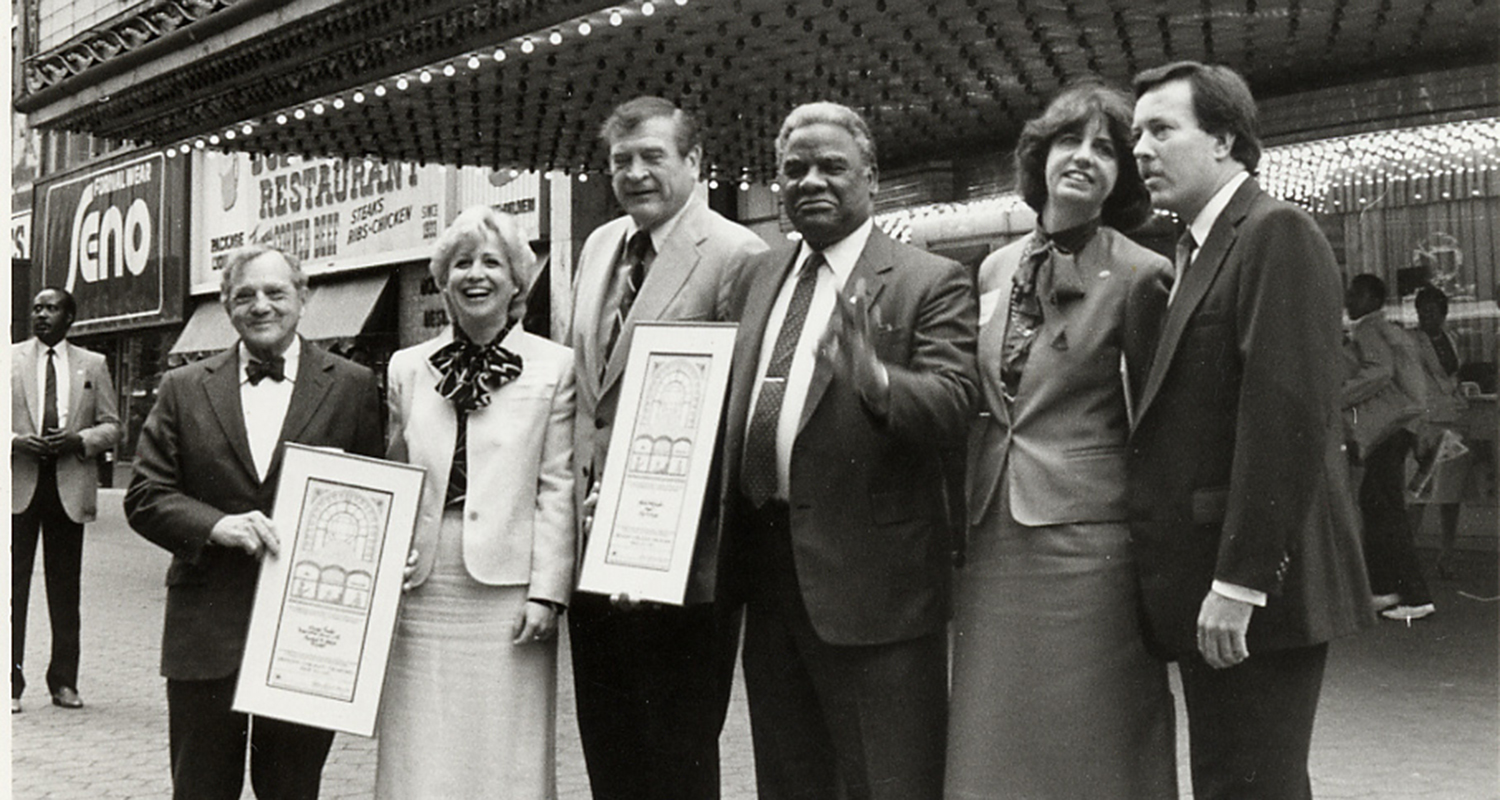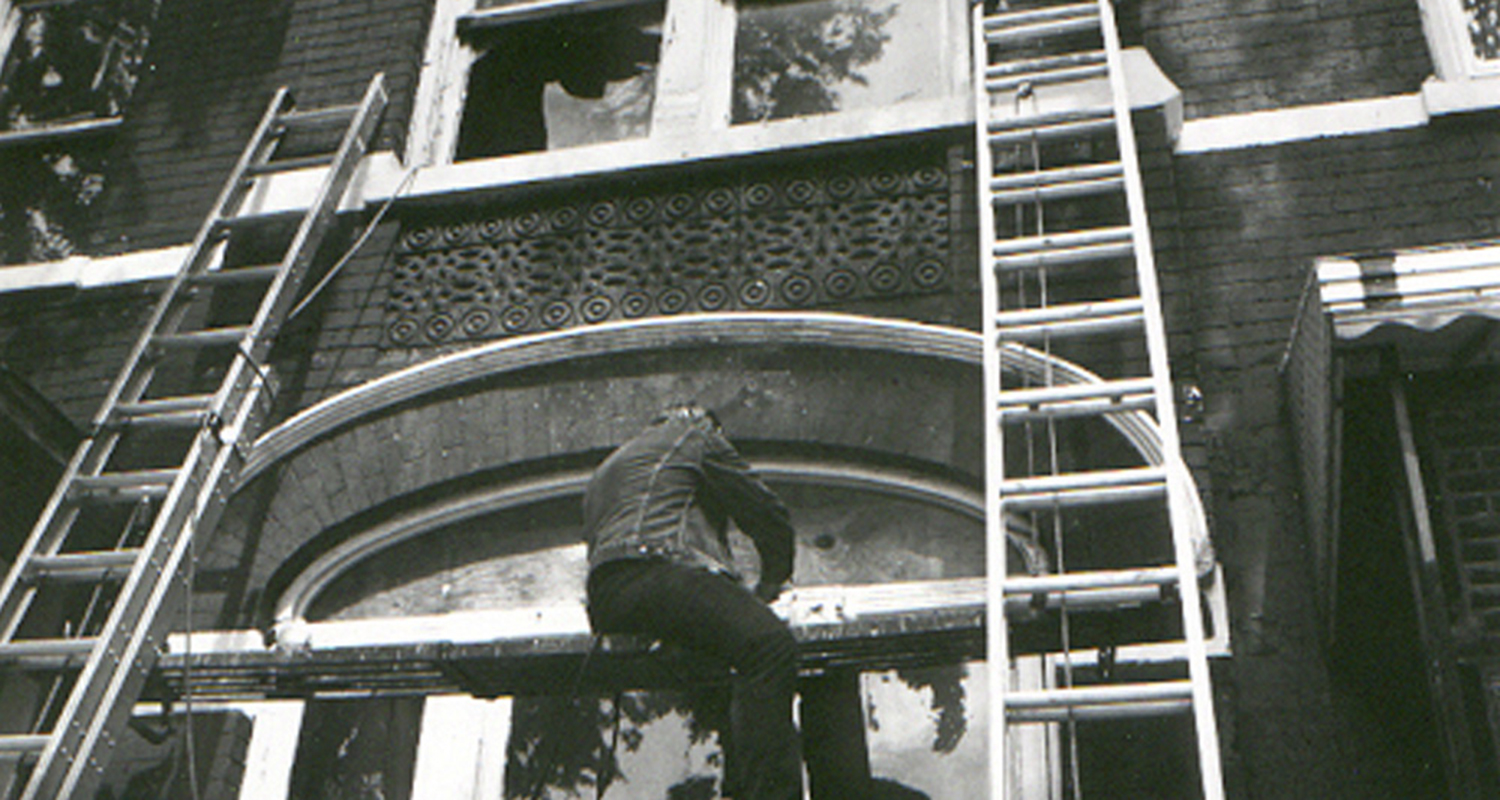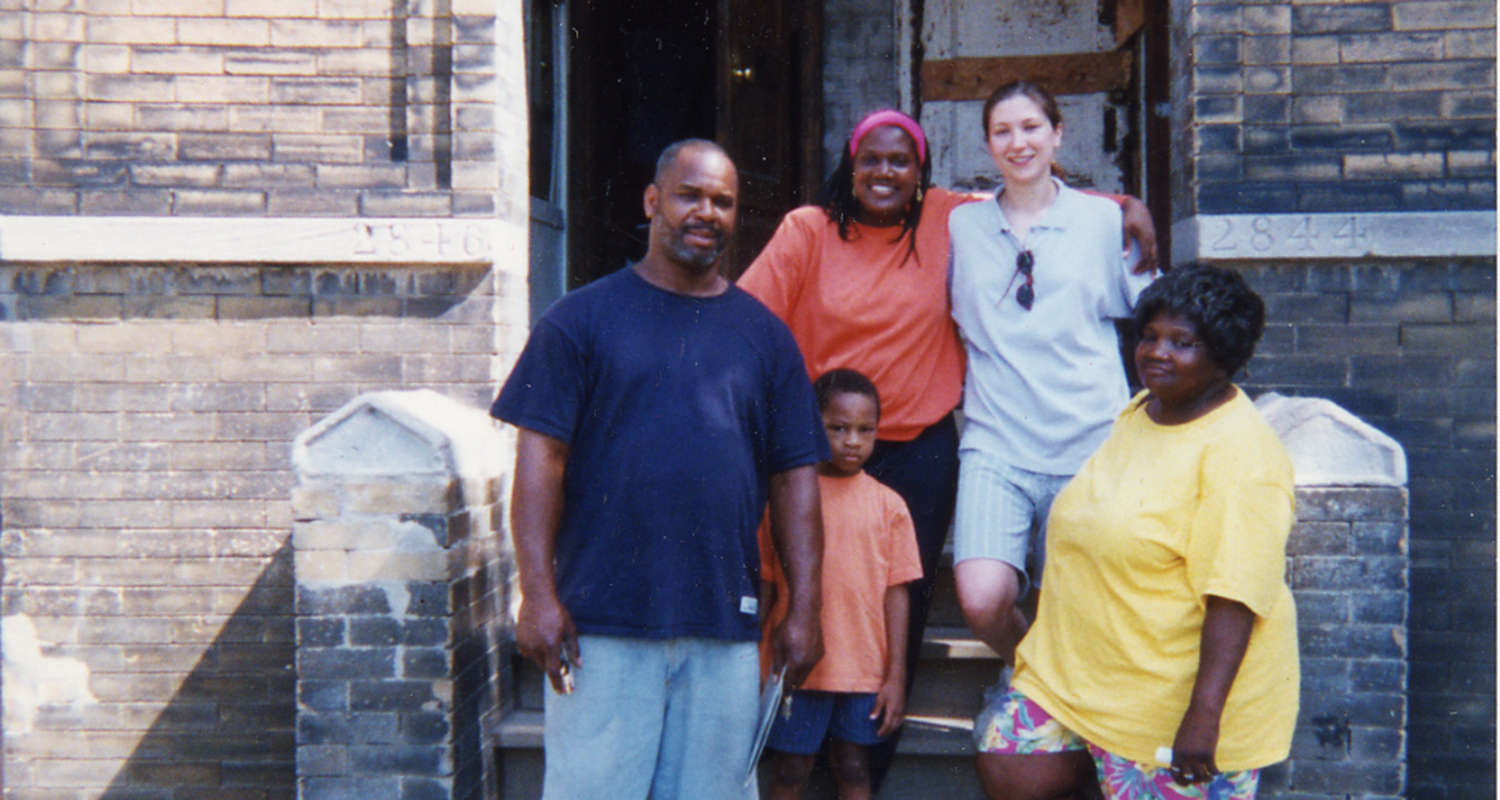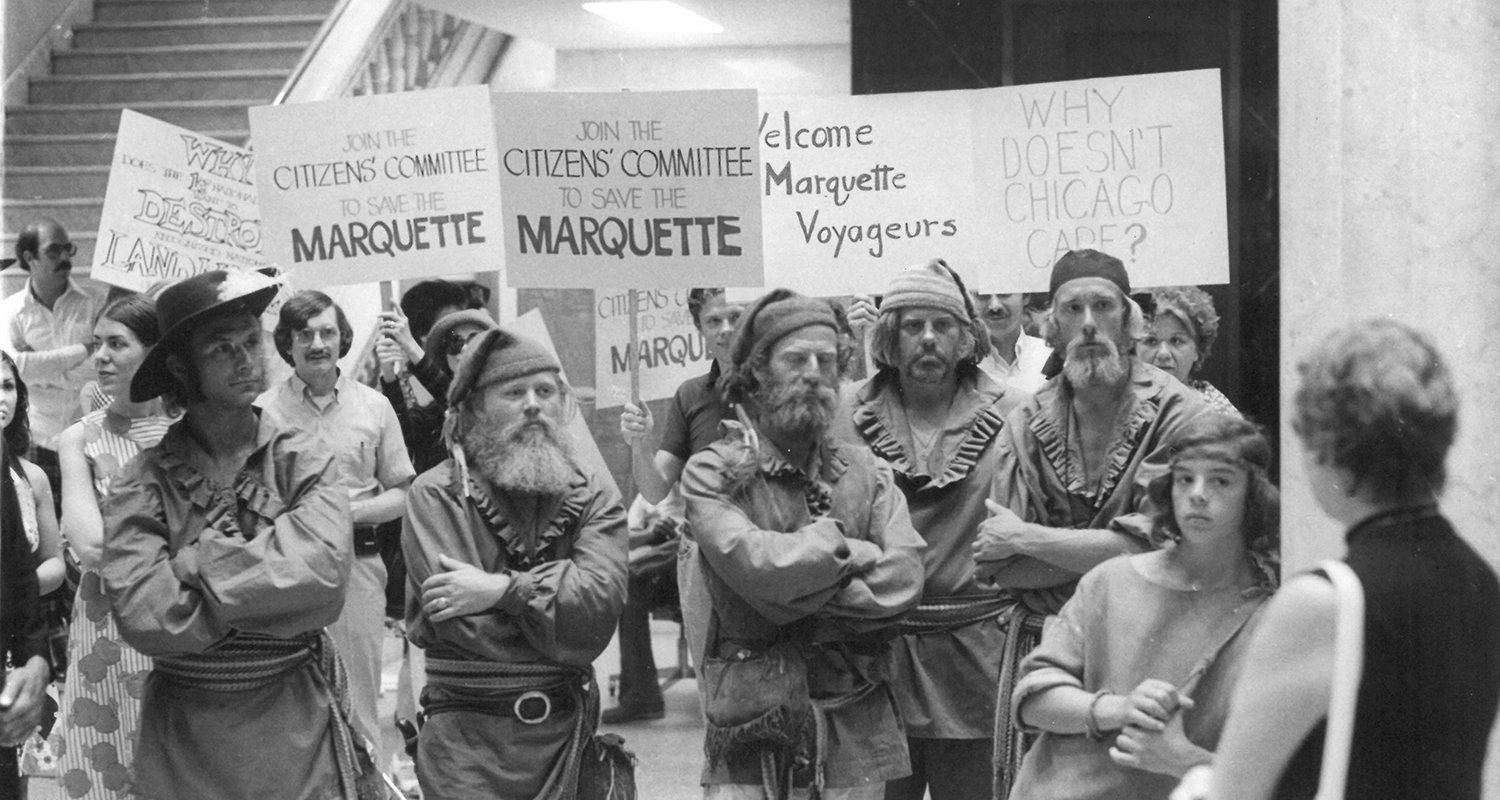SAVE BUILDINGS
Landmarks Illinois’ list of accomplishments is impressive. After leading the charge to save the Stock Exchange, the fledgling organization improved its ability to garner popular, political, and media support. The Marquette Building, the Chicago Theater, the Reliance Building, and St. Mary of the Angels Church in Chicago, as well as the Bloomington Courthouse Square, Oakbrook’s Mayslake, and the Zimmerman farm archaeological site are among the places that Landmarks Illinois has helped save for future generations.
In 1976, Landmarks Illinois saved the Henry Demarest Lloyd House in Winnetka in by employing an untested preservation tool: a conservation easement. A conservation easement requires all subsequent owners to preserve and maintain the critical historic features of a property in perpetuity. After the Henry Demarest Lloyd House was donated to Landmarks Illinois, a conservation easement was placed on it and it was then resold to private owners. Today Landmarks Illinois holds easements on over 400 properties and monitors their performance to ensure long-term preservation.
In neighborhoods with limited economic resources, Landmarks Illinois has occasionally taken on the role of owner and developer. Pulling together skilled professionals and volunteers, the organization rehabilitated three houses in the Tri-Taylor Historic District as well as two of the Frank Lloyd Wright-designed Waller Apartments. The finished residences were resold to moderate-income homeowners.
FACILITATE PRESERVATION
Throughout its history, Landmarks Illinois has sponsored legislation that removes obstacles and establishes incentives for preservation. Buildings can be lost because existing regulations and tax implications encourage demolition and new construction rather than preservation.
The first 5-year effort led to the establishment of the Illinois Historic Preservation Agency in 1976. Charged with administering statewide preservation planning, landmark designations, historic resource surveys, and review of the rehabilitation of historic buildings to ensure that they meet preservation standards, the agency has become a vital force for preservation in the state. Landmarks Illinois supports and cooperates with the state without losing sight of the need to push for even greater action at critical times.
Landmarks Illinois has been the initiator and supporter of much of the legislation that encourages preservation including tax incentives for the rehabilitation of historic buildings. The statewide property tax freeze for single family homes (later expanded to include owner-occupied multifamily residences up to six units) and the Cook County Class L incentive, which extends property tax relief to commercial properties, were major achievements of Landmarks Illinois. Hundreds of homeowners throughout the state have benefited from the property tax assessment freeze, while early results of the Class L program successes include the Crowne Plaza Hotel (formerly the Allerton) and the Wheeler-Kohn Mansion, both in Chicago.
Landmarks Illinois further facilitated preservation by introducing loan and grant programs. The Neighborhood Initiative made available loans of up to $10,000 for homes on Chicago boulevards. The Ida B. Wells House, the residence of the late 19th/early 20th century African American reformer, was among the homes to benefit from this program.
The Endangered Building Grants program offered small grants to help save buildings in critical need. During the 1999 legislative season, Landmarks Illinois succeeded in seeing a statewide Heritage Trust Fund established. Unfortunately, the program’s funding was eliminated in 2003.
To help fill the void, Landmarks Illinois created the Preservation Heritage Fund, into which the Endangered Building Grant program was folded, to provide greater assistance to preserve important structures and sites throughout Illinois. The Heritage Fund helps provide bricks-and-mortar assistance as well as assistance in funding studies, surveys, and building assessments. The fund also enables Landmarks Illinois to target long-term preservation initiatives that are linked to economic development, affordable housing, and neighborhood character.
EDUCATE
Citizens of Chicago and Illinois are vastly more aware today than they were in 1971 of the wealth of architectural and historic resources throughout the state, thanks in no small measure to Landmarks Illinois. Beginning with the first edition of the Loop Inventory in 1975, Landmarks Illinois has issued many publications such as technical briefs on historic building materials and design guidelines for rehabilitation of historic buildings. Preservation Snapshots, a monthly lecture series, and tours such as the Sacred Places Tour offer attendees a wealth of architectural and preservation knowledge. For over 20 years the organization has sponsored a statewide preservation conference that brings together preservation experts and those seeking preservation advice. Held in historic communities throughout the state, the conference has increased awareness of important but often overlooked historic buildings, sites, and districts in the smaller cities and towns of Illinois.
PROMOTE
In the 1990s, Landmarks Illinois introduced two initiatives–the Most Endangered Historic Places in Illinois and the Richard H. Driehaus Foundation Preservation Awards–that shine a greater spotlight on preservation.
The Most Endangered Historic Places in Illinois program, begun in 1995, draws attention to the most critical preservation problems faced by the state each year. The publicity and media attention surrounding the announcement of each year’s list has contributed to the saving of numerous historic places that reflect the richness of the state: the Grand Valley of the Kickapoo archaeological site; the Skokie North Shore train station; the Wagner Farm in Glenview; and the Frank Lloyd Wright-designed Glasner House in Glencoe, among others.
The Preservation Awards Program, begun in 1991, honors various aspects of exemplary preservation efforts — rehabilitation projects, publicity, educational programs, advocacy, community leadership, and the Preservation Project of the Year. The program is now called the Richard H. Driehaus Foundation Preservation Awards in honor of its sponsor. Recent winners include the Hard Rock Hotel (in the Carbide and Carbon Building) in Chicago, the Coronado Theatre in Rockford, and Orion’s Central Park Bandshell.
THE FUTURE
Landmarks Illinois has grown over the last 45 years into a mature, stable, not-for-profit organization. Although it has never lost sight of it mission, it is no longer the scrappy organization it started out as. Protests, picket lines, and lawsuits are still effective tools, but so are diplomacy and compromise. Today government officials, developers, and property owners recognize Landmarks Illinois’ expertise and listen to what it says. Landmarks Illinois intends to be relevant and active for the next 45 years and beyond. Its goal is to ensure that the architectural and historic resources of Illinois endure so that future citizens may enjoy the physical presence of their cultural heritage.
~Contributed by Victoria Granacki, former Landmarks Illinois Board Member




